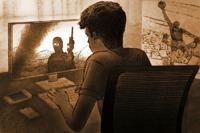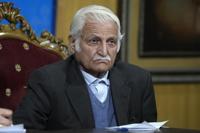PARIS (AP) — After his arrest, the boy's mother was stunned to discover that her 12-year-old had been learning how to kill and gorging on videos of decapitation and torture so gruesome they made even case-hardened French court officials look away. The mother told criminal investigators that she'd thought her son had been playing video games and doing homework during the hours he spent in his room.
The child's descent into the internet's darkest recesses started innocently enough, with online searches about Islam after an aunt gave him a Quran as a gift, says the boy's lawyer. From there, more searching, automated algorithms that steer users' online experiences and the boy's curiosity ultimately led him to encrypted chats and ultraviolent propaganda pumped out by militants and other extremist groups that are worming their way via apps, video gaming and social media into the minds of the very young.
Paul-Edouard Lallois, the French prosecutor who secured the boy's conviction on two terror-related charges last August, says the thousands of images and other extreme content that the child viewed so warped his understanding of the world and of right and wrong that "it will take years and years of work to enable this kid to recover normal bearings.”
The prosecutor believes that left unstopped, the boy was on a trajectory to possibly becoming a “completely dehumanized soldier” who risked joining the ranks of digitally radicalized teenagers in France and beyond who are hatching terror plots and expressing support for extremism. The huge library of violent content, several terabytes of data, that the boy amassed included video tutorials on bomb-making, the prosecutor said.
“It is possible to completely upend the mental bearings of such a young child,” he said. "Do that for a few years and, even before he has turned 18, he's already capable of, yes, committing an attack and the worst things with just a knife.”
An emerging global threat
Across Europe and further afield, the picture is similar: Counterterrorism agencies are grappling with a new generation of attackers, plotters and acolytes of extremism who are younger than ever and have fed on ultraviolent and potentially radicalizing content largely behind their screens. Some are appearing on police radars only when it's already too late — with knife in hand, as they're
Olivier Christen, France's national anti-terrorism prosecutor who handles the country's most serious terror investigations, has a firsthand view of the surging threat. His unit handed terror-related preliminary charges to just two minors in 2022. That number leapt to 15 in 2023 and again last year, to 19.
Some are “really very, very young, around 15 years old, which was something that was almost unheard of no more than two years ago,” Christen said in an interview with The Associated Press. It “demonstrates the strong effectiveness of the propaganda disseminated by terrorist organizations, which are quite good at targeting this age group.”
The so-called “Five Eyes" intelligence-sharing network that usually shuns the limelight, comprising U.S., U.K., ��ɫtv, Australian and New Zealand security agencies, is so alarmed that it took the unusual step in December of calling publicly for collective action, saying: “Radicalized minors can pose the same credible terrorist threat as adults.”
In Germany, an Interior Ministry task force launched after is focusing on teenagers’ social networks, aiming to counter their growing role in radicalization. In France, the domestic DGSI security agency says 70% of suspects detained for involvement in alleged terror plots are under the age of 21.
In Austria, security services say , with an 18-year-old and a 17-year-old, for an alleged to slaughter was radicalized online. So, too, was a suspected ISIS supporter, aged 14, for an alleged plan to attack a Vienna train station, Austrian authorities say.
The VSSE intelligence agency in Belgium says almost a third of suspects detained there for plotting attacks from 2022 to 2024 were minors — the youngest only 13. Extremist propaganda “is just a click away for young people in search of an identity or a purpose,” it said in a report in January, with radicalization occurring at speeds that are “nothing short of meteoric."
A path from porn to jihadi propaganda
Counterterror investigators say the online radicalization of a child can sometimes take just months. Digitally nimble, kids are adept at covering their tracks and skirting parental controls. The 12-year-old's mother had no inkling that her boy was consulting extremist content, the family’s lawyer, Kamel Aissaoui, told The AP.
And unlike previous generations of militants who were easier for police to track and monitor because they interacted in the real world, their successors are often interacting only in digital spaces, including on encrypted chats to mask their identities and activities, investigators say.
"They live on their phones, their tablets, their computers, in contact with people they don’t know," said a senior official from a European intelligence agency who spoke to The AP on condition of anonymity to discuss its work combatting illegal extremist activity.
Some start "to imagine who they would attack, how they would go about it, doing actual reconnaissance, hunting for a weapon, consulting tutorials on how to make explosives,” the official said.
For some kids, the process starts with violent pornography or a fascination for gory images, counterterrorism investigators say. From there, more clicks can lead to grisly and ultimately to jihadi decapitations, throat-slitting and torture, in videos that are sometimes slickly produced with music and are shared on chat groups.
“Often they’re heavy consumers of everything that is broadcast on the Web and especially things that are forbidden,” said Christen, the French national anti-terror prosecutor. "It’s something of a chain reaction that gets them to the ultra-violence disseminated by jihadi movements.”
Kids from all backgrounds
Aissaoui, the child's lawyer, said the trial was so tough on the 12-year-old that the hearing had to be paused twice because he was so distraught. He says the boy isn't violent and was simply a victim of apps and other digital tools that expose kids to extremist content.
“He was directed from site to site, and so on and so forth, until he came across things he should never have seen,” the lawyer said.
The boy is now in residential care without access to social networks, with specialized educators and regular visitation rights for his parents, the prosecutor told AP.
Counterterrorism investigators say they're dealing with kids from an array of backgrounds. Some have behavioral difficulties and some tend to be loners whose social interactions are largely virtual, but others raise no concerns with their behavior before it draws police attention.
Police analysis of the 12-year-old boy’s computer and phone found 1,739 jihadi videos, “a phenomenal quantity of scenes of decapitation, throat-slitting, shootings,” the prosecutor said. He also had how-to videos on bomb-making and killing, including one that appeared to show the real-life death of a tied-down man being methodically chopped into pieces.
“I have seen some horrible things in my career,” he said. “But this goes beyond all comprehension.”








































